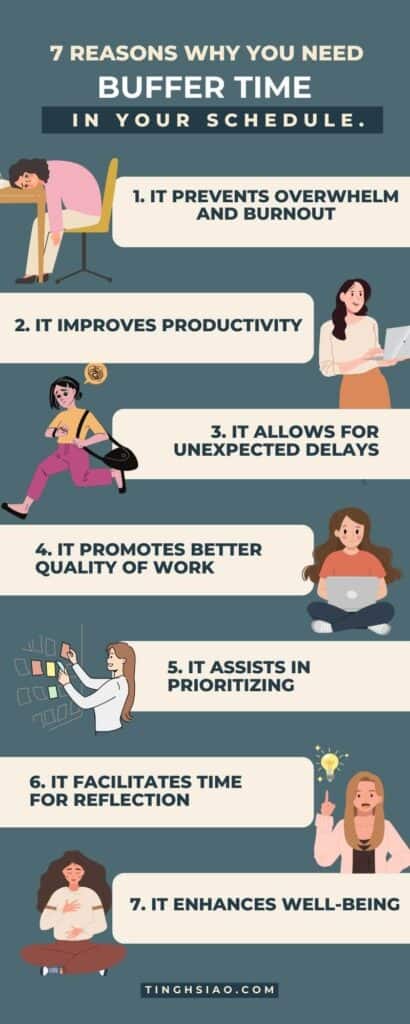7 Compelling Reasons Why You Need Buffer Time In Your Schedule
Have you ever felt like your daily schedule is a runaway train? One meeting rushes into another, tasks pile up, and before you know it, you’re gasping for a moment to catch your breath. This isn’t just your story, but the tale of countless professionals navigating the relentless pace of modern life.
A potential solution? Buffer time.
This is no magic formula, but a simple, scientifically endorsed strategy that encourages allocating free time between tasks in your personal schedule or your work from home schedule. By integrating buffer time, you can regain control, boost your productivity, and improve your overall well-being.
Did you know that it takes an average of 23 minutes and 15 seconds to refocus after being distracted? Adding buffer time can help minimize interruptions and enhance your efficiency.
In this blog post, I will share seven compelling reasons why integrating buffer time into your daily routine is crucial. Whether for project management or personal tasks, it’s not just a good idea, but essential. So, are you eager to transform your frantic routine? Let’s jump right in!
Key Takeaways
- Buffer time, a scientifically endorsed strategy, involves adding free time between tasks, leading to increased control over schedules, improved productivity, and overall well-being.
- On average, it takes approximately 23 minutes to regain focus after an interruption, which can be minimized by incorporating buffer time.
- Buffer time is not just beneficial but essential for efficient project management and personal tasks.
- Adding buffer time can transform chaotic routines into structured schedules, promoting efficiency.
What is Buffer Time?
The concept of buffer time might still be new to some of you. So, what exactly is it?
In simple terms, buffer time is a strategic reserve of time that you place between tasks, meetings, or appointments.
This reserve could be as short as 5 minutes or as long as an hour, but its purpose remains the same: to provide an opportunity for rest, reflection, or preparation for what’s next.
It’s like a breather between two rounds of a boxing match, giving you the chance to catch your breath, plan your next move, and move forward with renewed vigour. This strategic pause could potentially be the difference between a burnout and a productive day.
Why Should You Use Buffer Time?
So, why should you use buffer time? First and foremost, it helps you avoid stress. Life often throws curveballs our way, and tasks don’t always go as planned. Buffer time allows you to adapt to these changes without feeling overwhelmed.
Personally, I’ve found that having some extra minutes between tasks or meetings has helped me maintain my focus and stay on top of my priorities.
Here’s a real-life scenario: during a particularly stressful week, I allocated buffer time in my schedule with the help of AI Scheduling Assistants. This small adjustment resulted in a noticeable reduction in my stress levels and a significant enhancement in my focus. I found that the buffer time gave me the much-needed breathing room to prepare for the next task or meeting, resulting in better output and productivity.

Now, let’s dive deeper and explore seven compelling reasons why incorporating buffer time into your schedule can make a significant difference. Buffer time:
1. Prevents Overwhelm and Burnout
Buffer time is like a breath of fresh air in an intense focus marathon. It allows for breaks between strenuous tasks, giving your mind a chance to rest and recharge. This, in turn, wards off feelings of overwhelm and burnout.
2. Improves Productivity
It’s a common myth that stuffing our schedules to the brim equates to high productivity. However, buffer time defies this misconception. It offers the mental space necessary for enhancing focus and eventually, productivity.
3. Allows for Unexpected Delays
Even with careful planning, unexpected delays are bound to happen. That’s where buffer time comes in, allowing for these unforeseen hiccups without throwing off your entire schedule.
4. Promotes Better Quality of Work
When you’re sprinting from one task to another, the quality of your work is at risk. Buffer time lets you transition between tasks smoothly, ensuring each one receives the attention and quality it deserves.
5. Assists in Prioritizing
A schedule with buffer time discourages overcommitment. It fosters a realistic appraisal of what’s achievable in a given timeframe, helping you prioritize more effectively.
6. Facilitates Time for Reflection
Buffer time isn’t just a pause between tasks. It’s an opportunity to review your progress, reassess your goals, and tweak your strategy as needed.
7. Enhances Well-being
The ceaseless rush of today’s world can be detrimental to your health. Buffer time allows for self-care activities, thus enhancing your overall well-being and happiness.

How to Allocate Buffer Time and Use It Wisely?
So, how exactly do you go about allocating buffer time in your schedule?
It’s not always easy to know how much buffer time to add. It often depends on the nature and urgency of the tasks, their complexity, and your personal preferences.
For example, if an important meeting is coming up, I would give myself more buffer time to ensure I’m well-prepared. Buffer time can be used strategically to review your goals, counteract potential problems, and even recharge.
With that said, let’s dive into how you can make the most of your buffer time by following these 5 simple steps:
Step 1: Assess your tasks and identify the need for buffer time
Evaluate your projects, meetings, and other tasks that frequently experience interruptions or unpredictable elements.
Consider how long these meetings tend to last and the potential for unexpected pops or delays. This assessment will help you determine the need for buffer time in your schedule.
Step 2: Estimate buffer durations based on past experiences
Reflect on previous instances when you encountered time crunch anxiety or missed deadlines due to unforeseen delays. Use this information to estimate how much extra time, such as half an hour or more, you typically require as a buffer.
Applying risk management principles, consider allocating a slightly larger buffer than your initial time estimate.

Step 3: Strategically plan buffer time
Incorporate buffer time into your schedule by planning ahead. Allocate pockets of time, such as thirty minutes between tasks or meetings, to serve as buffer zones.
Treat this buffer time like a pocket watch, guarding it against interruptions and distractions that can scatter your focus.
Step 4: Utilize buffer time proactively
When unexpected events occur, make the most of your buffer time. Instead of feeling mentally scattered or rushed, use this extra time to catch up on pending tasks, review and revise your work, or engage in proactive risk management strategies. Prioritize the most important tasks or those with approaching deadlines.
Step 5: Reap the benefits and adjust as needed
Enjoy the several benefits of allocating and using buffer time effectively. Reduced stress, more realistic time management, and fewer missed deadlines are just a few advantages. Pay attention to how well your buffer time serves you and make adjustments over time to ensure it remains a huge help in your project management endeavors.
By following these five steps, you can master the art of allocating buffer time and leverage it wisely to enhance your productivity, reduce stress, and navigate unexpected challenges more effectively.
Final Thoughts
Buffer time is a powerful tool in your time management arsenal. It offers a safety net against unforeseen delays and interruptions, assists in strategic planning, and promotes proactive utilization of time.
Also, it provides benefits such as reduced stress and more realistic time management, which heightens your productivity.
Regularly assessing and adapting your buffer time allocation, along with the integration of a few AI productivity tools, can effectively meet your evolving requirements.
Follow the five steps to allocate, safeguard, utilize, and modify your buffer time, and you will experience firsthand how it enhances your ability to manage your projects and tasks. So, start allocating buffer time today and reap its numerous benefits!
Also read: Common Time Wasters in the workspace






